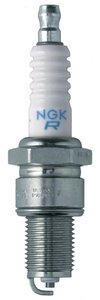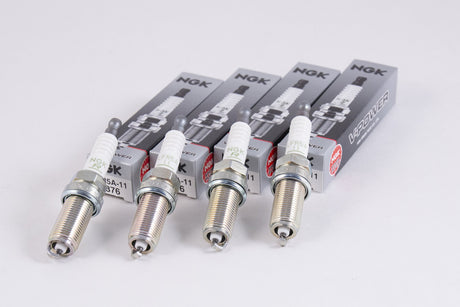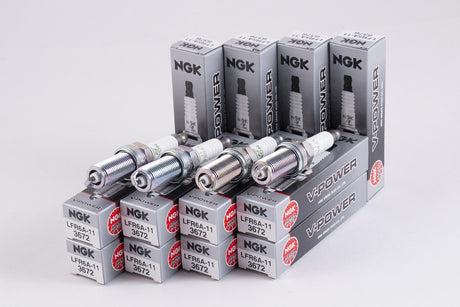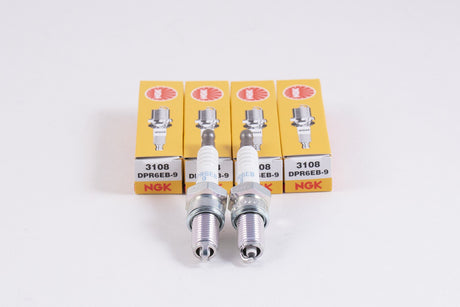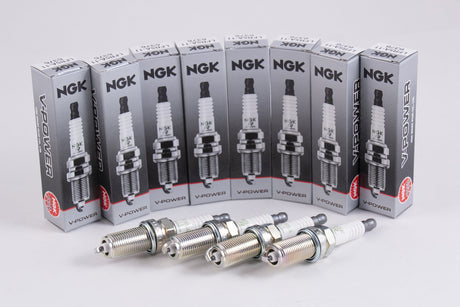-
NGK SPARK PLUGS
STANDARD SPARK PLUGS (NGK SPARK PLUGS) 11- 6376 - LFR5A
$8.88$16.73Unit price /Unavailable -
-
-
-
-
NGK SPARK PLUGS
NGK LKR6E (92650) Multi-Ground Plug Spark Plug - 4 Pack
$39.32Unit price /Unavailable -
-
-
-
-
-
-
NGK SPARK PLUGS
NGK Laser Iridium Spark Plugs, ILMAR7E9 #94698
$19.28$32.49Unit price /Unavailable -
NGK SPARK PLUGS
NGK LKR6E (92650) Multi-Ground Plug Spark Plug - 8 Pack
$78.64Unit price /Unavailable -
-
-
-
NGK SPARK PLUGS
NGK Spark Plugs - #6668- LFR6A - Sold Individually
$8.90$14.99Unit price /Unavailable -
-
-
-
NGK SPARK PLUGS
NGK LKR6E (92650) Multi-Ground Plug Spark Plug - 12 Pack
$117.96Unit price /Unavailable -
-
-
-
-
-
-
-
-
-
-
-
-
-
Yamaha Marine Engine Spark Plugs and Ignition Components Resources and Information
A key component of your boat's engine, marine spark plugs take in high voltage electricity at one end and ignite a spark at the other end. That spark fires the air and fuel mixture within your Yamaha outboard engine and creates the combustion that powers your boat. While spark plugs and ignition coils aren't the same, they're both parts of a vehicle's ignition.
We stock a complete range of Yamaha outboard parts, and other spark plugs and ignition components to help you service your Yamaha outboard motor, including:
We also regularly release new helpful resources like:
Yamaha Outboard Spark Plugs & Ignition Components FAQs
How do Yamaha outboard spark plugs work?
Yamaha outboard spark plugs supply the spark that ignites the air-fuel mixture, creating the explosion that allows your boat’s engine to produce power. Spark plugs generate an arc of electricity across two leads that are not touching but close enough together that electricity can jump the gap between them.
How often should I change my Yamaha outboard engine spark plugs?
Boaters debate the answer to this question. Some boaters are adamant about changing their spark plugs every year or 100 hours. PartsVu recommends religiously inspecting your spark plugs annually or every 100 hours, replacing them if they are fouled or damaged, and always replacing them every 300 hours.
How do I perform spark plug and compression maintenance on my Yamaha outboard motor?
Performing Yamaha spark plugs and compression maintenance on your outboard is one of the keys to its overall longevity and reliability.
Begin this step of your Yamaha 100-hour service by removing the plastic shrouding over your spark plugs or ignition coils. Yamaha engines come from the factory with NGK brand spark plugs, and PartsVu carries a wide assortment of these OEM plugs. In most applications, the spark plugs come pre-gapped, but it is advisable to re-check the gap to make sure that no plugs were damaged during manufacturing or shipment. Again, the information in your owner’s manual is helpful – or you can consult our Yamaha Engine Specifications and Capacities Chart.
As you remove the old spark plugs, keep track of which plugs come from which cylinders. Note if the plug appears to be wet from water, oil, or gasoline. Note if the plug exhibits evidence of heavy carbon deposits, other fouling, or rust – all indicative of other problems. If you were to take your engine to a dealer for 100-hour service, this is the point at which they would perform a compression test by connecting a compression gauge to the cylinders individually and using the starter motor to turn the engine over and check its ability to pressurize the cylinder. If you are going to perform this test at home, you will either need a remote starter button or a friend who can turn the ignition key with the kill lanyard removed. This cranking with the ignition disabled will also prime the fresh oil around the block, reducing friction at startup after the service is complete. Repeat testing for all cylinders and compare results. Readings will vary from gauge to gauge, so the test is more about measuring the difference in readings with ideal results being less than a 10 percent variance.
With the compression test completed – or skipped – you can now begin installing your new spark plugs. For ease of removal and to reduce the risk of thread damage to the cylinder head, apply a drop of oil with the tip of your finger to the threads of the plug using care to avoid wetting the electrode or porcelain center of the plug. Thread the plugs into the cylinder head by hand using caution not to cross thread. NGK uses a crush washer that will press down and provide a tight seal as you tighten – full torque is between 18-21 ft. lbs. Reinstall the plug wires or coils in the same order and use a small amount of Yamaha grease for the threads of the bolts, coils, and covers.
When should I change my Yamaha 4-stroke outboard engine’s spark plugs?
For most boaters, pull Yamaha four-stroke outboard spark plugs every two hundred hours or every other season and check for proper color and wear. They should be a light brownish color and have relatively sharp edges. When necessary, replace with the exact manufacturer and part number that your outboard’s manufacturer stipulates. The brand type and style of spark plugs used in your outboard are designed as they contain specific performance attributes that are engineered for your outboard’s operation.
Does my Yamaha outboard head gasket need to be repaired?
Do you believe that your Yamaha outboard head gasket is in bad shape?
Your Yamaha outboard head gasket is a very important component in the performance and lifespan of your engine. Located between the cylinder head (where your spark plugs are screwed in) and the cylinder block, a head gasket is responsible for sealing these components together to withstand the compression from the engine and enable cooling water to flow between the block and the head.
Like most outboard components, parts age through usage and time. Head gaskets that are regularly exposed to excessive heat, corrosive saltwater, and other substances will eventually reduce the integrity of the gasket.
However, if a head gasket is not replaced when it begins to fail, water will begin to enter the engine. Once this happens, the performance of your outboard will be significantly affected and eventually lead to major engine damage.
To avoid this, there are a number of telltale signs to look out for when it’s time to replace your Yamaha outboard head gasket, including:
- Reaching the 4-Year Mark
- Low Pressure in the Cylinders
- Water Coming Out of a Spark Plug Hole
- Black Specks, Crud, and Slime in the Cylinder
- Idle Runs Too Slow or Rough
- Holes In the Head Gasket
How much does it cost to replace a Yamaha outboard head gasket?
If you choose to replace your Yamaha outboard head gasket yourself, you can only be on the hook for parts ($50 or less for many engine models) and tools (many of which you may already have in your toolbox).
Taking your outboard to a mechanic will include the cost of parts, but also labor. Considering labor generally costs between $70 – $120 (or more!), the total cost of just a head gasket replacement can be a few hundred dollars. Of course, the advantage of a head gasket replacement by a mechanic is that they can make other replacements, trim the heads if they’re warped, and diagnose any other developing issues that may be plaguing your Yamaha outboard.
How do I unclog my Yamaha outboard motor fuel pump?
Many Yamaha 115 4-stroke problems such as starting issues and misfires can come from clogged fuel injectors.
Fuel injectors can become clogged due to carbon build-up that prevents a smooth distribution of fuel. When this occurs, your outboard may misfire, vibrate excessively, and bog down during idle or when throttle is applied.
As part of keeping your Yamaha 115 4-stroke problems to a minimum, cleaning your outboard fuel injectors with fuel injector cleaner will keep your motor performing at its best.
To give you an idea of what tasks, tools, and equipment you will need with a DIY project, here’s what’s involved when cleaning your fuel injectors:
- First, you’ll need to remove the fuel injectors off of the engine, which includes the fuel rails. (Note: There are other methods of cleaning your fuel injectors that enable you to perform this repair while the fuel injectors remain on the engine).
- Carefully remove the rubber O-rings and gaskets from each fuel injector.
- Once removed, manually clean the injectors with a rag and fuel injector cleaner to remove any surface debris.
- Next, you will take a length of fuel hose and clamp the fuel injector to one side of the hose.
- Fill the fuel hose with an ample amount of fuel injector cleaner.
- On the other side of the hose, you will clamp it to an air compressor to create an imitation of the pressure in the engine and force the fuel injector cleaner through the injector’s nozzle. (Note: There is specialized equipment for this task)
- Supply power to the injector to allow the air and fuel injector cleaner to move through the nozzle using a battery and a pair of spade connectors
- Apply air pressure to the hose and quickly tap on the battery to send voltage to the fuel injector, opening and closing it (to simulate its regular function). This enables the fuel injector cleaner to flow through the fuel injector.
- Repeat the process until each of the fuel injectors have been cleaned.
Make sure your Yamaha outboard engine starts up every time by replacing your old Yamaha spark plugs and ignition components. Choose from PartsVu.com's complete selection of certified Yamaha OEM replacement parts.

